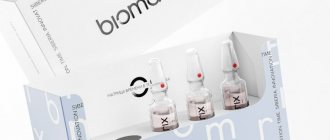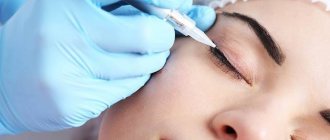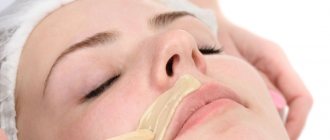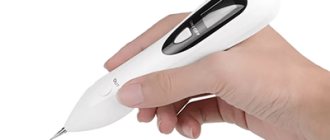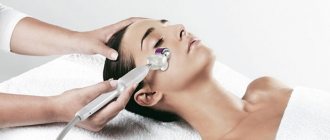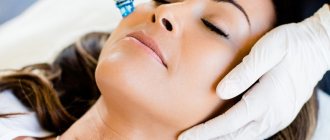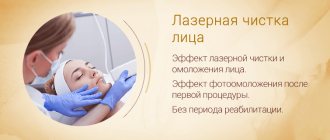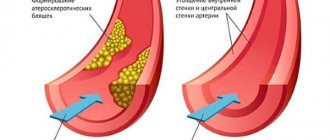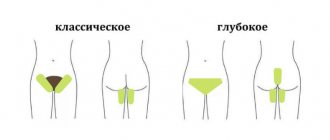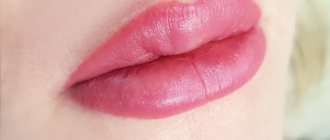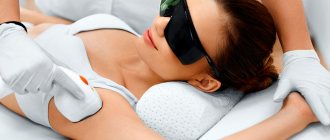Rating: No rating
Photoepilation is one of the most popular and sought-after types of hair removal, which will cleanse the skin of excess hair and completely stop its growth . Many women have appreciated the benefits of this procedure, and after spending time on several sessions, they enjoy smooth and clean skin without irritation.
The essence of the procedure
The photoepilation procedure includes several stages:
- If you decide to start a course of photoepilation, then you cannot shave your hair a month (at least 7 days) before the procedure .
- First, a consultation is carried out , during which the skin type, hair pigmentation color and possible contraindications (chronic diseases, allergic reactions, inflammatory processes) are determined.
- During the procedure itself the patient is reclining in a comfortable chair.
- Eyes must be protected with special glasses .
- The place where hair will be removed is treated with a special cooling gel , which transmits light pulses well.
- The specialist who conducts the photoepilation session acts on the skin area with short (fractions of a second) flashes of high-intensity light, which is generated into thermal energy and passes along the hair shaft to the follicle, greatly heating it. Under the influence of heat the follicle weakens and gradually (from session to session) collapses.
- Since the skin has a huge reserve of hair follicles at rest, at least ten such procedures must be carried out with an interval of one month , when the active phase of new hair growth begins.
- At the end of the procedure, the gel is wiped off, and Panthenol or another soothing agent is applied to the skin to prevent redness of the skin.
Difference from other hair removal methods
Photoepilation is not the only way to combat unwanted hair. Its main competitors are laser and electrolysis. What is the difference between them?
Photoepilation or laser
A laser beam and a light pulse are almost equal in their effectiveness on the hair follicle. However, laser use causes redness and swelling of the skin. In addition, burns and bruises may occur. During the “laser” session, the client experiences pain, so before starting the procedure, the specialist applies an anesthetic to the skin.
Electrolysis against light pulse
Photoepilation is not able to eliminate some types of hairs (gray hair and vellus hair). In this case, electrolysis is considered unsurpassed, during which each hair is removed separately. However, it should be understood that such a procedure is quite lengthy, painful and expensive. Using electrolysis it is impossible to treat large areas; this method is used only for small areas (for example, face, bikini).
Pros and cons of the method
According to Karina Lebedeva, dermatologist-cosmetologist at the NUANCE clinic in St. Petersburg, photoepilation has a number of advantages over other methods of hair removal:
- Firstly, the light flash affects the entire color spectrum of hair (with the exception of gray hairs).
- Secondly, this is a fairly painless method.
- Thirdly, photoepilation is a non-invasive method, therefore the risk of infection is reduced to zero.
- It is also important that after the procedure there are no burns left on the skin.
Physiotherapist, specialist at the OASIS beauty, SPA and fitness center Olga Kulkova considers the painlessness of the method and a minimal number of contraindications to be a clear advantage of photoepilation.
It should also be added that:
- the procedure can be applied to any part of the body;
- depending on the skin type, hair color and the treated area, you select your own mode for delivering light pulses, which ensures the most effective hair removal without causing undesirable consequences;
- the effect of photoepilation can last from 6 months to several years;
- The maximum time for the procedure is 20 minutes.
However, photoepilation also has its disadvantages, which the client needs to know about before starting the procedure:
- this method is ineffective for light-colored hair;
- gray hair cannot be removed with its help;
- it is impossible to get rid of all hairs in one session;
- in some cases, exposure to a light beam can cause peeling of the skin;
- an incorrectly chosen regimen provokes side effects.
Video: specialists about photoepilation
What are the types
The photoepilation procedure can be carried out in any area where unwanted hair grows:
- on the face (includes hair removal from the eyebrow space, from the upper lip and chin, as well as from the cheekbones and neck);
- in the armpit area;
- on hands;
- on the back and stomach;
- in the bikini area;
- on foot.
If you want to get rid of unwanted hair and know for sure that you have no contraindications, then this procedure is quite possible to carry out at home using a photoepilator.
In other cases, it is best to contact specialized medical centers, where photoepilation is carried out by a medical professional using a stationary device for professional use.
How to properly prepare for photoepilation?
Beginners in this business should understand that the final result of photoepilation depends on the quality of preparation. If you follow all the recommendations that were prescribed by the master, the result will not take long to arrive. Not only the quality of hair removal, but also the level of skin protection depends on the correctness of the preparatory stage. Experienced professionals at beauty salons who perform photoepilation recommend abandoning any methods of hair removal and depilation one month before photoepilation. It is permissible to use only a razor. It is not advisable to remove hair using any other methods, as this will affect its quality.
In order for light flashes to penetrate deep into the hair, its length should be no more than 2 mm. To do this, 1-2 days before photoepilation, the hair in the selected area must be shaved with a razor so that by the time of photoepilation it has time to grow to the required length. It is not worth growing longer hairs, since the light flux will have a greater impact on the surface of the hair itself, and not on the follicle.
2-3 weeks before photoepilation you should not go to the beach or sunbathe in a solarium. Since the skin absorbs ultraviolet radiation as much as possible, after additional treatment it may react by causing burns. You should not decide on photoepilation if you have a good and lasting tan.
On the day of photoepilation, you should not apply any cosmetics to the treated area of the body, especially for facial skin. They can cause a decrease in exposure to light waves.
Also, various drugs can affect the body during this period. Therefore, before photoepilation it is necessary to stop taking any antibiotics and tranquilizers. Only after complete recovery can you begin this cosmetic procedure.
Where can I do this procedure?
Photoepilation has a number of limitations, so it is very important to contact specialized medical centers or clinics with good customer reviews, where a qualified medical professional will study your problem and identify all possible contraindications.
Where to do photoepilation in Moscow
- Center for laser cosmetology "ANV": Moscow, st. Malaya Dmitrovka, 8, building 1, tel..
- Clinic of aesthetic cosmetology “Telos Beauty” : Moscow, st. Donskaya, 32, tel..
- : Moscow, st. Druzhinnikovskaya, 15, tel..
Where to do photoepilation in St. Petersburg.
- Medical: St. Petersburg, st. Marata, 2, tel..
- Center for professional hardware hair removal "Oda": St. Petersburg, st. Gzhatskaya, 22, tel. +7 (921) 981 99 45.
- : St. Petersburg, st. Prosveshcheniya, 49, tel..
Where to do photoepilation in Kyiv
- Clinic “Diamondlaser”: Kiev, st. Bolshaya Vasilkovskaya, 89, tel. +38.
- Center for laser cosmetology "Lazerhouse": Kiev, st. Bolshaya Vasilkovskaya, 92, tel. +38.
- Beauty salon “Dissar”: Kiev, st. Vyshgorodskaya, 45/2, tel. +38.
How to register a hair removal and depilation business
To open an hair removal and depilation office, you need to register an LLC. An individual entrepreneur is suitable only if the entrepreneur has a doctor’s diploma and 5 years of work experience in his specialty. The hair removal room must have a medical license. Medical licenses are issued by the Federal Service for Surveillance in Healthcare and Social Development for a period of five years. The organization submits an application and a package with the following documents:
- Charter, constituent agreement.
- Certificate of state registration of the organization in the Unified State Register of Legal Entities.
- Certificate of registration of the organization with the tax authority.
- Goskomstat codes (93.02. Provision of services by hairdressers and beauty salons).
- Extract from the Unified State Register of Legal Entities.
- A document confirming payment of the license fee for consideration of an application for a license.
- Title documents for non-residential premises: lease agreement, certificate of ownership.
- Floor plan of non-residential premises.
- Explication to the floor plan of non-residential premises.
- Documents confirming ownership of equipment or other grounds for using equipment (for example, inventory cards).
- Certificates of quality of medical equipment.
- Registration certificates for medical equipment (if the equipment was produced and purchased by the organization later than 2000).
- Contract for maintenance of medical equipment.
- Diplomas, certificates, certificates for specialists (senior and (or) paramedical personnel).
- Documents confirming higher medical education in the field of healthcare from the head or deputy head of the licensee organization, documents on additional professional education, as well as certificates of a specialist in the specialty “Healthcare Organization and Public Health”.
- Order on the appointment of a person responsible for medical activities.
- An employment contract, a work record book of an employee appointed responsible for medical activities, confirming the presence of at least 5 years of work experience in the specialty.
- Sanitary and epidemiological conclusion on the compliance of the premises with sanitary standards and rules of medical activities.
Since obtaining a license is a process that requires knowledge of bureaucratic intricacies, many applicants resort to the services of law firms. The cost of these services is about 40 thousand rubles in the regions and about 100 thousand rubles in Moscow.
Many people wonder whether a license is needed for depilation services that do not destroy hair follicles (on the Internet, depilation is often classified as a household service, citing regulatory documents of the Ministry of Labor). The answer is necessary, since depilation is included in medical activities according to the Order of the Ministry of Health and Social Development of the Russian Federation of December 27, 2011 No. 1664n “On approval of the range of medical services.”
Possible consequences
- Burns occur when the procedure technique is violated and are accompanied by blisters, redness of the skin, and swelling. These consequences are caused by improper cooling of the skin, high power or prolonged exposure to pulses.
- Scarring occur due to the healing of deep burns.
- Pigmentation can appear as patches that are lighter than the skin (hypopigmentation) or patches that are darker than the skin (hyperpigmentation).
- Visual impairment is a consequence of the fact that special protective glasses are neglected during the procedure.
- Photodermatitis, or high sensitivity of the skin to light, is manifested by allergic reactions on the skin in the form of rashes and redness. People with thin white skin are susceptible to this disease.
- Oncological diseases of the skin occur rarely and are provoked by severe violations in the technology of using equipment.
How does photoepilation work?
In order not to fall for an inexperienced specialist, you must first learn all the intricacies of photoepilation. Of course, at the first consultation, professional hairdressers should tell you in detail how to properly care for your skin before photoepilation. When all the preparatory steps have been followed, you can begin the photoepilation itself.
Photoepilation begins with the application of a cooling gel. If this is LHE hair removal, then the gel should not be used. In all other techniques, the gel should be used, as it not only reduces pain, but also helps the light impulse to act on the hair follicle faster. Next, the master must provide both himself and the client with special glasses that will protect the eyes from negative bright light from the flashes of the device.
Photo of facial photoepilation in a cosmetology salon
After applying the gel, the master begins to work with the manipulator on the selected area of the body. The flashes that the device will produce should be short but strong. It is worth noting that the manipulator affects all hairs that are exposed to the light flash. The effect of the device does not occur singly on each hair, which significantly saves the time of the procedure.
After photoepilation, the specialist should treat the treated area of skin with a special soothing gel or softening aerosol. Such preparations often contain regenerating substances, so the skin quickly recovers and loses possible redness. After completing the procedure, the master must tell you in detail how to properly care for the treated surface.
The cost of photoepilation differs markedly in each salon. Often, the price of photoepilation depends on the quality of the equipment used, the time of the procedure, and the area being treated. The average cost of photoepilation can vary from 2000 to 6000 rubles.
A selection of reviews about photoepilation with photos
In our selection you will find reviews from those who have undergone photoepilation. Their photos will show you the results that can be achieved with this procedure, and our expert will comment on each case.
Review of photoepilation of the deep bikini area
Inna, 26 years old
Thanks to the enthusiastic reviews of my friends, I decided to have a deep bikini photo-epilation and I want to show you the “before” and “after” photos. Even in the area of the lower abdomen and along the bikini line you can see how effective photoepilation is. I like that my skin is smooth and clean, without any irritation. And most importantly, after just ten procedures I can forget about shaving and its unpleasant consequences forever.
Expert comment: This type of hair removal, when hair is removed from the deep bikini area, is called Brazilian hair removal. Thanks to this photoepilation, women can feel comfortable in a swimsuit, which is the reason for the high demand for this procedure.
Review of facial photoepilation for men
Nikolay, 28 years old
I decided to undergo this procedure on the advice of my friend. The reason for contacting the hair removal center was my ugly stubble, which grows unevenly. I managed to get rid of it in seven sessions of photoepilation, and now I have forgotten about shaving forever.
Expert's comment: Permanent hair removal has long gone beyond the scope of a purely female procedure and is extremely popular among men.
Review of photoepilation of the upper lip (mustache)
Irina, 20 years old
Having a mustache like a young man’s has developed a lot of complexes in me. They are quite dark and immediately catch the eye. I decided to get rid of them once and for all by going to a specialized clinic. I had ten photoepilation sessions, which lasted no more than five minutes. The only unpleasant thing I felt was a slight tingling of the skin during the outbreaks.
Expert's comment: This is a very illustrative example of successful photoepilation. We also recommend paying attention to hair removal in intimate places, because this is no less important for every girl than a well-groomed face.
Review of photoepilation of legs
Anastasia, 32 years old
Hairy legs on a woman are simply unacceptable, so, tired of experimenting with depilation, I decided on the long process of getting rid of hair through photoepilation. The result is simply perfect! Now no more growing prickly hair and irritation. The skin on your feet is soft and smooth!
Specialist comment: We recommend that you make a correction six months after the last procedure to consolidate the result. We also recommend paying attention to epilation of the intimate area.
Review of chin photoepilation
Zinaida, 51 years old
Due to age-related hormonal imbalances, coarse, dark-colored, male-type hair began to grow on my chin. Regular shaving did not solve the problem, and the growing stubble became stiffer. With the help of photoepilation, I managed to regain my femininity and close this delicate topic forever.
Expert's comment: We would like to draw your attention to the fact that photoepilation is now available at home using a compact Philips photoepilator, which is already on sale.
Review of photoepilation of the armpit area
Irina, 40 years old
I decided to start my acquaintance with photoepilation with hair removal in the armpit area. After the fourth session, only a few hairs remained to grow, which were almost invisible. By the end of the course, my armpits were simply perfect.
Expert's comment: Photoepilation, despite the long period of sessions, is a more effective method of hair removal than waxing.
Video: how to choose the right home photoepilator
Photoepilation is a relatively quick and painless way to combat facial and body hair, which has a minimum of contraindications and side effects. Proper preparation for the procedure and following the doctor’s recommendations after it will allow you to forget about this delicate problem for a long time, giving you smooth and delicate skin.
- Author: woman
Rate this article:
- 5
- 4
- 3
- 2
- 1
(0 votes, average: 0 out of 5)
Share with your friends!
Video block about photoepilation
In this video block you can see how a photoepilation session goes, hear reviews from those who have done photoepilation, and learn how you can do this procedure at home.
- Video with a review of photoepilation at home.
- A video about how photoepilation works, the principle of its action, and a review of the sensations during the procedure using the example of hair removal in the armpit area.
- Video review of all types of photoepilation : face, armpits, bikini area and legs.
- Video demonstrating bikini area photoepilation .
- Video tutorial from an expert about photoepilation at home.
- Review of photoepilation at home .
- Video about how photoepilation of the upper lip and chin is carried out in the salon.
- Review of photoepilation of hands with a demonstration of the process and expert comments.
An alternative to photoepilation today is laser hair removal. Reviews from doctors about these procedures are divided, so you yourself, having studied all the intricacies, must determine for yourself which is better - laser or photoepilation. Tell us about your preferences in the comments and share your hair removal experience.
Consumer Reviews
Those who have already experienced the delights of photoepilation note the quick and lasting effect, for which it is worth enduring the pain.
Feelings: of course, the procedure is not pleasant, there is a burning sensation from photo flashes, but these are short-term flashes, there is time to rest. At the same time, the armpit area is quite tolerable, over time it even stopped reacting, the bikini area - there are very sensitive places when it actually shuddered, but I think that all this is tolerable, fast and the result is worth it. After the first session, a few days later the hairs began to fall out in clumps (I was told not to shave so that the result could be seen) and grow extremely slowly. At first I went for photoepilation once every one to one and a half months, then less and less, my hair practically stopped growing. For me it was simply magical: the irritation went away, the skin brightened in the areas where I shaved, and the unpleasant darkening that I was embarrassed about disappeared. Armpits and bikini became smooth. Overall, I couldn't stop looking at it. And I couldn’t be happier, because compared to how I used to have to shave once every three days and feel a constant burning sensation from irritation - for me it was just a thrill.
Valencia
https://otzovik.com/review_3028431.html
Experienced clients of beauty salons recognize the highest effectiveness of this method of combating unwanted hair.
I have done all types of hair removal and I can assure you that photoepilation is the most effective hair removal procedure!!! Smooth skin of bikini and legs without stubble and ingrown hairs, I guarantee!!! No razor, only a combination of photoepilation + wax gives an amazing result.
Consumer inessa012 shows off smooth skin after treatment
inessa012
https://irecommend.ru/content/fotoepilyatsiya-luchshe-eshche-ne-pridumali
However, this procedure is not successful for everyone.
It's been two years since I had this procedure. My cosmetologist recommended it to me. I went to a good clinic. I hadn’t read reviews on the Internet before, so I trusted the professionals. In general, it was painful, in response to my request to do less, she said: “There is no room for less, I do my face at less power.” We had a procedure for photoepilation of all legs. It was very painful, everything turned red, the pain did not stop for about a month, the marks turned into sores and became crusty. Then the scabs fell off and in some places there were scars, but mostly just pigment stripes. And now two years have passed, and I’m still like a striped tiger. Pants in winter, long skirts in summer, I can’t swim or sunbathe. I spent a lot of money on different whitening products. Of course, now everything is much paler than it was, but there are spots all over my legs. Before you decide to do the procedure, carefully read the reviews, listen to the advice and try one flash on your skin first. Everything is individual.
Mirella_Vinc
https://irecommend.ru/content/bolshie-oslozhneniya-ozhogi-pigentatsiya
To avoid such troubles, before visiting a cosmetologist, you should carefully read the reviews about the clinic and contraindications to the procedure.
How long can the results last after photoepilation?
Judging by the reviews of satisfied clients, on average, the result of photoepilation can last about 4-5 years. During this time period, hair stops growing altogether. If all photoepilation technology was correctly followed, then a lasting result occurs after 4-8 procedures. Don’t think that after one photoepilation your hair will stop growing forever. This simply cannot happen. By nature, we have both active hairs and “dormant” hairs. It is the “sleeping” ones that begin their activities after the active ones are removed. After 1 procedure, experts claim that only 20-30% of active hair is removed. For a lasting result, up to 10 courses may be needed, because everything depends on the area of treatment and the individual characteristics of the person.
Photo of the photoepilation result
But there are cases when photoepilation does not maintain a lasting effect. This can happen for several reasons at once. Firstly, the wrong equipment was selected or the wrong mode was set. Secondly, the client did not follow the cosmetologist’s instructions correctly before and after photoepilation.
In 2007, American scientists conducted a study in which they wanted to find out how long the result after photoepilation could last. The experiment involved 207 people who were specially selected with the same skin type and color. The indicators of all participants in the experiment were taken into account in the study, since people had unwanted hairs removed from different parts of the body.
Photo of back photoepilation
Most people had two to six treatments, but there were cases where repetitions of up to 10 and 13 were required. For correct calculations, the average was calculated. At the end of the entire course of photoepilation, each of the respondents was surveyed regarding the effectiveness of the procedure performed. As a result, it turned out that 45 participants in the experiment were very satisfied with the durability of the result, 93 respondents limited themselves to a satisfactory rating, and 69 participants were dissatisfied with the result. Scientists have concluded that in order to achieve a full, lasting result, some people need to carry out single procedures after 6 or 12 months. This is the only way to achieve what you want, because not everyone has the same color and hair growth activity.
What should be the care after photoepilation?
Often, one procedure will not be enough to get rid of annoying body hair for a long time, or forever. Therefore, masters suggest using entire courses of procedures that are designed for complete hair removal. Therefore, care after photoepilation should be appropriate. To ensure that the same good effect is maintained after subsequent procedures, you should not use any other means of hair removal or depilation between sessions. Experts recommend using only a razor during this period.
After photoepilation, you must use sunscreen for a whole month. It is these highly protective products that will help the skin survive the effects of ultraviolet rays. This is especially true for those clients who have undergone photoepilation on their faces. Without the use of sunscreen, redness and pigmentation may occur.
Do not apply alcohol-containing compounds to the treated area. This exposure can have a negative effect on the skin. Firstly, it can become even more inflamed. Secondly, alcohol will cause severe drying of the epidermis.
You cannot visit solariums or go to the beach to sunbathe for 2 weeks, this is especially important for those who have sensitive skin. It is also important to avoid visiting saunas and steam baths, at least for the first 5-7 days after.
Are there any contraindications to the use of photoepilation?
Photoepilation is based on the effect of strong light flashes on the body. These outbreaks cause the hair follicles to heat up and die. This effect on hair and skin may negatively affect the health of some groups of people.
Photoepilation is contraindicated for pregnant and breastfeeding women. During this period, women have a particularly low pain threshold, so any negative emotions can negatively affect the health of mother and child.
The photo shows self-photoepilation
Photoepilation is contraindicated for those who suffer from viral or infectious diseases. The immune system is weakened during this period, so it will be difficult for the body to bear the additional load on the skin.
Photoepilation should also not be used by those who have malignant or benign formations of any nature. This is especially important for those people who have a large scattering of moles or birthmarks on their bodies. Also, you should not use photo-exposure to waves on the skin where there is a tattoo.
If there are keloid scars on the skin, or a person is prone to their formation, then you should not start photoepilation. Any skin diseases, such as rashes, allergies, psoriasis, eczema, are a contraindication to the use of this type of body hair removal.
People with epilepsy should not use photoepilation services. Any negative psycho-emotional impact can trigger an attack. Photoepilation is contraindicated for those who have external damage to the skin. Persons who have not yet reached 16 years of age should not undergo photoepilation.
If you do not listen to these recommendations, then various kinds of exacerbations of diseases may occur after photoepilation. Beauty salon masters may not always be conscientious about their work, so it is better for the client to undergo an additional examination by a dermatologist.
